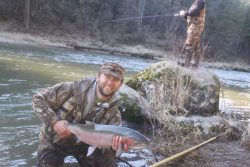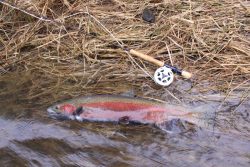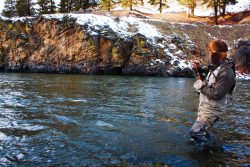Do Steel head create fanaticism?
They do it by refusing to bite for weeks while staging in the deep pools of northern rivers under three feet of ice. I know they are there, so I stand in mid-winter steelhead water ever hoping to be there when the switch is flipped somewhere amidst thousands of pre-spawning heads of steel. The singular moment when the feeding frenzy begins transforms the dormant masses into pairs of relentless forward progress. When the movement begins these fish hammer nearly everything thrown into the water on the end of a line. If you’re there when it happens, fanaticism is born. It happened to me by chance and I can’t shake it loose. No matter how many fishless days I spend on the river, I can’t stand the thought of missing the run when it happens; Steelhead create fanaticism.
Maybe it’s the angler who brings fanaticism to the river bank and the steelhead is innocent, doing nothing more than instinctively fighting for survival. That could be – an internal affliction that steel-heading fanatics are born with and can’t escape. One too many episodes with singing reels and leaping fish triggers the addiction. I’ve never heard of a 12 step program for steel-header’s but I’m sure there’s a market for counselors. Although they would have to hold classes when steelhead season is closed or I would never make it to the meetings.
I’d say I might be late but I know better; there’s no pulling away from the river when the steel head are biting and there’s nothing I hate worse than hearing an angler on the river say, “You should’ve been here Tuesday!” Those words are unacceptable unless I’m hearing them coming from my own mouth. I was probably there on Tuesday anyway so I’m sure they aren’t talking to me. Besides, no one likes a quitter.
My own steelhead fanaticism developed over a period of years. Through stubborn optimism I found success on the Salmon River in Idaho just an hour and a half from my house. Each time a rosy cheeked steel head found its way to the net my enthusiasm grew. But it wasn’t just the net, it was the whole process.
First, feeling the split shot contacting the rocks below the surface tick…tick…tick. In a rhythmic trance I cast; tick…tick…reel, cast… repeat.
Suddenly and without warning the ticking changes to a thud, a soft and subtly different feeling coming more from my stomach than any discernible sensation transmitted from the line to my rod. I set the hook hard on instinct then stare at my rod tip to see if the line is going to move. Half a dozen snags every hour will develop a tinge of doubt in anyone. Ziiiiip! My reel screams, line peeling off faster than my mind can comprehend.

I’ve learned to step back and pull the rod in whichever direction is needed to steer the fish away from the current. These fish don’t need any more advantages than their own natural abilities already grant them. If the steel torpedo rockets downstream I follow quickly. If it goes upstream I say a silent prayer of thanks and keep steady pressure on my rod. The line bows downward and I know the fish is about to launch from the water in aerial defiance. My hand spins the reel as fast as it can while my rod drops hard to the water absorbing the looming slack about to come. Slap! With a splash my rod slings upward, deliberate and hard, resuming the tension and preparing for the fish’s next move.
Eventually, if everything went right, if I did everything right and the fish did nothing wrong, I reach into the water gripping the tail of an anadromous trout that for countless thousands of years has survived the journey of up to 1,200 upstream miles in these rivers. The weight of the rivers flow not enough to discourage an impossible journey to the head waters lying hundreds of miles from the open ocean where they’ve somehow survived for two or three years. They press onward against the current and the odds with no tangible reward; they’re more likely to die after spawning than to return once again to the open ocean.
Shivering in the early morning hours one cold January day on the Salmon River in Idaho I wore a fur hat and wool gloves to keep my blood from freezing leaving just enough dexterity in my fingers to pop ice off the eyelets of my fly rod. A good fly with the unfortunate name of “Green Butt Skunk” adorned the end of my line. Long casts to cover the river continued for hours. Except for the rare vehicle or two that came by and stopped to watch the crazy S.O.B dodging chunks of floating ice in January I was alone on the river.

A short cast into a familiar riffle tailing out into a flat edge was ticking along as usual when suddenly my arm shot upward involuntarily. My rod was bent. My reel held fast, for a moment. And then it started; the fever of spring steelhead came on like the bubonic plague and didn’t stop.
Catching steelhead is tough for lots of reasons but
I have forgotten most of the days spent casting into empty water last year. I’ve forgotten the days of line frozen to eyelets, numb fingers, snow and rain. Lamenting over days of rising muddy waters and waters too low and clear to sneak up on fish are a distant memory – replaced instead by memories of success. Soon the days will begin to cool. Steelhead that will be present in Idaho Rivers this winter and spring have already begun their journey from the ocean.
They are on their way. Actually, they’re already here it’s me who is almost ready. I can’t decide if steelheads create fanaticism or if it’s the steel-headers who bring fanaticism to the river bank. Either way, when the run begins, my rod will bend to the experience that can only exist if the fish and I are both there when it happens.